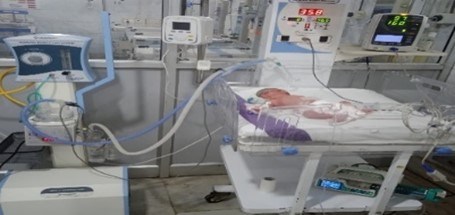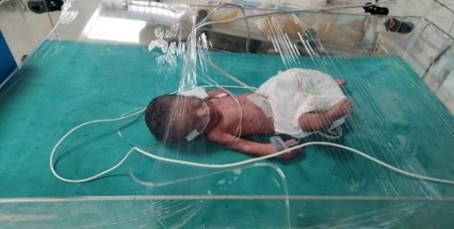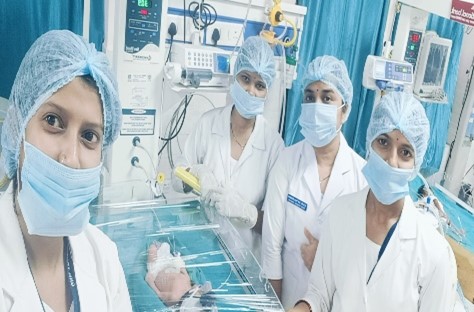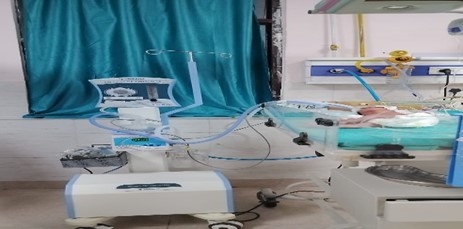Welcoming a newborn into the world is a joyous event, brimming with hope and dreams. Yet, for some families, this journey can be challenging, especially when their baby is born prematurely or requires specialized medical attention. In such cases, access to exceptional neonatal care is critical. The Piramal School of Leadership -School of Health (PSL-SOH), committed to societal welfare, fully understands the necessity of high-quality neonatal care provided by Special Newborn Care Units (SNCUs).
Though it may be too early to measure the full impact of training in terms of outcomes, its immediate effects can certainly be observed. The essence of any training program lies in ensuring participants gain comprehensive knowledge, enabling them to apply it effectively and share their learning by training other staff members. PSL-SOH and the State Health Society Bihar (SHSB) had high expectations after training SNCU staff on the management of sick and premature newborns and the use of Continuous Positive Airway Pressure (CPAP) therapy. Upon completing the training, three separate WhatsApp groups were created for paediatricians, medical officers and staff nurses, connecting all SNCUs in Bihar. These groups also included nodal officers from SHSB, PSL-SOH, and trainers, acted as platforms for SNCU staff to share their successes and challenges in managing neonates using CPAP. Trainers also provide suggestions for improvements through these groups.
The increased use of CPAP machines is expected to lead to improved patient outcomes among newborns. These outcomes include a reduction in respiratory distress, as CPAP helps stabilize breathing and prevent respiratory failure. Enhanced oxygenation levels are likely, as CPAP ensures a continuous flow of oxygen into the airways, improving blood oxygen saturation. Now, it's time to witness the impact of this training on neonatal care. The success of the training can be measured by its practical application in clinical settings as participants returned to their districts. Rather than explaining it in our own words, we are showcasing success stories shared with us by those who experienced them firsthand through these WhatsApp groups.

SNCU - SITAMARHI
Triplet baby admitted on Saturday. Initially, they all had Respiratory distress. Gradually they improved with assisted ventilatory and other supportive therapy. Now, 2 of them are fine and have no Oxygen requirement and one baby is maintaining SPO2 on CPAP Ventilation. Sister Monika, who has got training in 29Feb-2 Mar batch is looking after the babies. Definitely, we will have better outcome with advance equipment and trained working hands 🙏🙏🙏

SNCU - ROHTAS
Today baby admitted, BIRTH WEIGHT-900gm,on admission weight-840 gm, gestation age-29wk age on admission-31 days , indication for admission -ELBW, RDS,PREMATURITY) on admission SPO2-82% immediate management CPAP MACHINE START,CLING WRAPS,NESTING,OG TUBE INSERT OPEN END. Isme meri SNCU ki on duty nursing staff and jo staff training k liye aai thi and hmare Nodel officer sir ka Sahyog h👌
SNCU – BANKA
A female baby received from RH bausi at 11:30 am on 07/05/2024. At the time of admission virals sign.... Spo2 :- 75% without Oxygen support . Pulse rate below 110 beat / mint . Indication of admission:- RDS, BIRTH ASPHYXIA, AND GRUNT. Initial care provided in sncu baby, put on the CPAP support immediately after that her vitals :- spo2 92-96% and pulse rate :- 135- 145 beat / mint. Also provide supportive care such as NESTING, WRAPPING, OG TUBE, Continue monitoring under cardiac monitor
SNCU - GOPALGANJ
B/O Sandhya devi Admitted in sncu gopalganj At, 9:10AM ON 04/06/2024 WITH COMPLAIN OF LBW (wt 1. 2kg) Prematurity( 30 weaks) Grunting, central cynosis Apnea. ON ADMISSION VITALS TEMP, 34.6°,HR 112 Respiratino 14 CRT prolong, Spo2 72% After Resascitation patient stable CPAP Start with method 5/50/5 HR 152 ,Resp 48 Spo2 96% to 98% RBS 113mg/dl RDS Chest retraction👍👍 B/o-Sita kumari wt -2800gm gestational age 39wks wks Indications BA convaltion RD C-PAP Start On Admission weight-2105gm Day of life-7days, gestation age-39wk,presenting complaint-irregular breathing, hyperthermia,APNEA, RDS, PERINATAL ASPHYXIA,on Admission SPO2-74% ON ADMISSION MANAGEMENT- suction,resucitation ,put on CPAP on 6/6/24,SPO2-92%-94% today baby SPO2-92%-94%maintain Out born ( HFR)

SNCU- VAISHALI
Baby birth weight 1.3kg, gestational Age26-28 weeks, cpap start first day of life

Baby wt- 1285 gm, gestation wk- 28wk,cling wrap, baby active in Rohtas. Management of cling wrap.

GNM students night duty Meri help krti hui or hmare dwara CPAP machine k bare m btate hue👍🏻
SNCU – LAKHISARAI
Preterm baby Bhola who weighed 800gm at birth was treated in SNCU for one month and then was followed up for one year. Today after one year the child is completely healthy and his weight is 6.710 kg.

SNCU - SIWAN
B/o Gulabsah Preterm baby Gestationel age 31 wks Admission by 30/5/24 Wt 1500gm Indication for Admission R.D.S Spo2 80% CPAP start than spo2 95 %to 98% Baby condition is improved baby active vital sign manten Out born baby in sncu
SNCU – AURANGABAD
Good to observe Aurangabad using CPAP for respiratory distress. Request sister to let us share brief history of patient.

SNCU JAMUI
PreteA Newborn baby admitted in SNCU jamui. Indication for admission prematurity, L.B.W, R.D.S, Grunting, Central cyanosis, Gasping. Baby wt. 1.140gm, on admission spo2 – 35%, CPAP start, now spo2 – 79%.
SNCU SAHARSA
27 week premature baby wt 955gm admitted with severe RDS ,spo2 75,put on cpap,after 12 hr pt improove spo2 95
SNCU KHAGRIA
Preterm baby admitted on 28/3/24,weight-1600gm.indication for admission-severe RDS,Put on cpap for 4 days and treated for 15 days.Today after 1 month the baby is healthy and weight is 2660 gm

DOA- 8/5/24,ON ADMISSION -1820gm, gestational wk-34 wk, indication of admission-RDS,on Admission SPO2-90% put on CPAP 9/5/24 at 10pm,SPO2-95%-96% CPAP REMOVE at 6Am on 10/5/24
SNCU - SUPAUL
Baby of Pramila Devi DoB-21/4/24 at 8 pm addmission on 22/4/24 at 12:10 Am B A /convaltion /RD/Hypoglycemia /granting Referred come from Pipra CHC C- CAP started at 10Am
These WhatsApp interactions highlight the training's effectiveness, evidenced by the increased confidence and competence of the staff in administering CPAP therapy and their adherence to established CPAP protocols and monitoring procedures. We have even observed the high motivation levels of some trained SNCU staff, who are enthusiastically training their peers in managing sick and premature babies and the operationalization of CPAP machines, evident through updates posted in the WhatsApp groups.
It is anticipated that the use of CPAP machines in district hospitals may reduce the number of referrals to medical colleges, thereby reducing the burden on these institutions and saving the lives of neonates who require immediate ventilation. As effective CPAP usage may reduce the need for invasive respiratory interventions such as intubation and mechanical ventilation, which carry risks for newborns. Thus, the widespread and increased use of CPAP machines can significantly enhance outcomes and overall care for newborns experiencing respiratory distress. The combined efforts of SHSB and PSL-SOH aim to reduce referrals from SNCUs by strengthening their services, thereby saving the lives of newborns who might otherwise be lost or suffer complications during transit to medical colleges.
However, as with any system, there are challenges, there is another side of the coin also. While more than 16 out of 35 district SNCUs have begun utilizing CPAP machines and are eager to share their achievements but still some districts are yet to start using CPAP despite undergoing training and follow-ups. Though along with our stakeholders we are following up with district officials to encourage the staff in these districts to operationalize CPAP. The PSL-SOH team, along with the SHSB team, is working to identify the reasons for this lag and address the issues, but still we are facing challenges. The state of the healthcare sector in Bihar is far from optimal, with significant shortages in facilities and staff, as highlighted by a Comptroller and Auditor General of India (CAG) report. This report, covering audits in five districts—Patna, Biharsharif, Hajipur, Jehanabad, and Madhepura—from 2014-15 to 2019-20, revealed a bed shortfall of 52 to 92 percent in district hospitals as per Indian Public Health Standards (IPHS).
Meanwhile, the Government of Bihar (GOB) is on the verge of establishing Paediatric Intensive Care Units (PICUs) and Medical Intensive Care Units (MICUs). PSL-SOH is committed to providing technical assistance to the GOB as needed for the benefit of society. Although infant and neonatal mortality rates in our country have been falling, the pace has been slower than expected, especially for neonatal mortality. Uttar Pradesh, Madhya Pradesh, Bihar, and Rajasthan collectively account for 55% of India’s neonatal deaths and 15% of global neonatal deaths annually. The prioritization and planning should be based on local data, needs, and geopolitical scenarios rather than a single national plan, which can provide broad guidelines. This situation prompts us to ask: should we explore the practices of other states or countries excelling in neonatal care to enhance our clinical practices, equipment, technologies, and human resources? Could we learn from neighbouring states like Kerala and Tamil Nadu or countries like Japan, Finland, Singapore, Sweden, and Norway, which boast the lowest neonatal mortality rates? Is there an urgent need to establish NICUs, PICUs, or MICUs to fortify neonatal care in Bihar and save more lives? Is there a need to strengthen emergency and specialty services at government district hospitals and sub-district hospitals? Is there a need for an integrated district-based model managed by empowered District Coordination Committees, ensuring a smooth flow of referrals and back-referrals between different levels of care?
TAGS
SHARE





